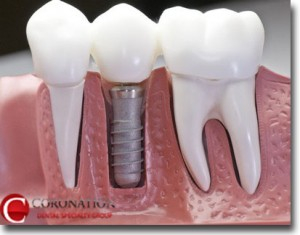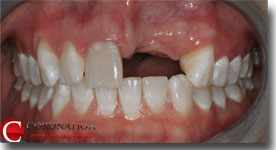Services > Implants > Dental Implants
One of the options to replace missing teeth is a Dental Implant. First applied to the dental field by Dr. Per-Ingvar Brånemark, the ensuing decades have proven that dental implants are a viable and reliable treatment option.
What is a Dental Implant?In its simplest form, a dental implant is a metal post that is placed into the empty bone where a tooth and its root are missing. The post has connections on which a crown can be placed afterwards. After everything is completed, only the crown is visible beside the other teeth; the post is hidden beneath the gum tissue. The implant and crown will then function and look like the root and crown of a natural tooth. |  |
There are other options to replace missing teeth. However, depending on the situation, dental implants can be advantageous.
Probably, but it depends! When evaluating someone for dental implants, it is important to perform a full clinical and radiographic examination and history.
First, it is important to start with a patient’s health history. Certain medical conditions (like diabetes) or habits (like smoking) may affect the healing of dental implants. In some cases, we may advise that dental implants are not a good option, if there are clues from the history that implants would not be successful.
 | Next, a full evaluation of the teeth and gums is completed. It is important to ensure that the surrounding teeth and gums are healthy, as these can have an effect on the health of dental implants. An evaluation of the remaining bone is also performed, to ensure that the implant will have proper stability and bone coverage when placed. In some cases, bone grafting may be required. |
It is also important to take proper x-rays prior to implant placement. Some of the most common are:
PA (periapical)
PAN (panorex or panoramic)
CT (CAT-scan)
The type of x-ray taken depends on the tooth being replaced, and on the clinical evaluation. X-rays can give an idea of the health of the bone in the area, the condition and position of the adjacent teeth, and the distance to adjacent structures (eg nerves, or the sinus). In addition, CT scans can look at the remaining bones in three dimensions, and in some cases can be used to plan the implant surgery on the computer, before any actual surgery is completed on the patient. When prescribing x-rays, we follow the ALARA principle – As Low As Reasonably Achievable. That means that we prescribe only the x-rays that are required to help with the surgery, in an effort to minimize radiation exposure to the patient.
Dental implant surgery is usually very straightforward. Some patients decide to be sedated for implant placement, while others prefer to be completely awake.
When the surgery begins, a drape is placed over the patient so that the instruments and equipment remain sterile – every effort is made to avoid contamination. Freezing is given around the gums and teeth, then instruments are used to gently prepare the site for the implant. We may have the patient open or close during the procedure, to ensure that the implant orientation is correct. In addition, surgical guides may be used to help position the implant properly. The implant is then placed into the site, and a few self-dissolving stitches are placed to hold the gum tissue in place. An x-ray will usually be taken to confirm implant placement. |  |
Patients will go home afterwards with written instructions, and usually a prescription for antibiotics and pain medication. Pain afterward is usually reasonable – most patients are surprised at how comfortable they feel.
Treatment time for dental implants will vary, depending on what procedures need to be done, and the length of time required for healing.
Typically, the implant is placed and undergoes a healing period before the crown can be placed. This healing period may vary, depending on whether any bone is required around the implant.
Furthermore, sometimes bone grafting is required as a separate procedure prior to implant placement. If so, there will be an additional healing period for the bone, before the implant can be placed.
In all, length of treatment typically varies between 2-3 months, up to 9-12 months. Again, this varies depending on the procedures that are required. The best way to what is involved and how much time is required would be to speak with your dentist, or to contact us and request a consultation for implant treatment.